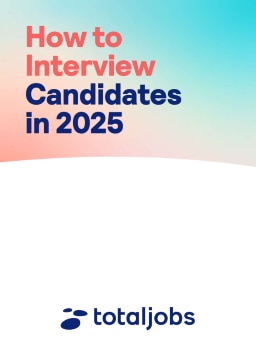
How to conduct a panel interview
Table of Contents
- What is a panel interview?
- Pros and cons
- Preparing for a panel interview
- Conducting a panel interview
- After the interview
- Panel interview questions
- FAQs

How to Interview Candidates
Traditional one-on-one interviews allow for an intimate discussion to take place between recruiter and candidate. However, any hire that requires input from a range of people can be a time-consuming process, a luxury employers can’t always afford in a competitive environment for attracting talent.
A long hiring process increases the chances of candidates accepting an offer from elsewhere, with research showing that more than three-quarters of jobseekers are likely to drop out of a long or complex recruitment process. With convoluted hiring testing the patience of even the most dedicated candidates, panel interviews can be an invaluable addition to an employer or recruiter’s arsenal.
In this article, we explore panel interviews, discussing their advantages and drawbacks, how to conduct them, and best practices to ensure they run smoothly.
What is a panel interview?
A panel interview is a structured formal interview process that involves two or more interviewers, or panellists, and a single applicant. A panel can be made up of representatives of different departments or may include the key stakeholders from one department, depending on the specific role you’re hiring for. They shouldn’t be confused with group interviews, which are interviews involving more than one candidate at the same time.
Who should be involved in a panel interview?
The hiring manager will always be present during a panel interview, but you will need to decide whether the role requires representatives from across the organisation, or within a single team.
A panel should typically include the following:
- Primary stakeholders (representatives of senior management)
- Team leaders or managers (who could be the direct line manager of the candidate, or working closely alongside them)
- HR representatives
Choosing panellists from the same team can help a candidate get a better feel for what their responsibilities could look like ‘in action’, as well as a feel for the colleagues they’ll be working most closely alongside. On the other hand, panellists from different departments can help a candidate understand their place in the wider organisation, and how their function contributes towards broader business goals.
It can also be useful to include a member of the HR team on the panel, who might have more experience conducting interviews. Either way, each panellist will have their own understanding of the role and what skills the ideal candidate will need to succeed.
The pros and cons of panel interviews
Panel interviewing can allow employers and recruiters to obtain a broader view of a candidate’s suitability for a role. However, it might not be right for every vacancy.
Let’s dive into panel interviews’ advantages and disadvantages to help you decide whether this interview format is right for you.
Advantages of panel interviews
Panel interviews bring several key benefits to the hiring process, offering a more dynamic and comprehensive way to evaluate candidates. Below are some of the main advantages this interview format provides:
- Reduce the impact of bias: Single-interviewer formats can magnify unconscious biases, leading to unfair assessments and potential discrimination that harms your reputation and causes you to overlook the best talent. An panel interview is one of the best ways to reduce bias during interviews, as panels have a more diverse range of experience and background.
- Go deeper with questioning: Panel interviews allow for a more comprehensive evaluation, as each panellist brings a unique perspective. This setup enables detailed questioning, with each person focusing on different aspects of the role, creating a broader assessment. Such diversity in questioning helps uncover a candidate’s suitability for the position and provides a richer understanding of their capabilities, which is vital for a skills-based hiring strategy.
- Showcasing company culture: Panel interviews offer candidates a first-hand look at your company culture. This format provides a glimpse into your workplace dynamics, allowing candidates to see how panellists interact and work together. This can help them gauge the level of teamwork and shared values within your organisation, and strong culture is one of the main things that can attract a top candidate.
- Assessing candidates in a group setting: Panel interviews can show you how candidates communicate, engage with different stakeholders, and respond to questions from various parts of the business. This is a valuable opportunity to assess their teamwork, communication skills, and ability to manage group dynamics. This can be especially helpful in improving your overall quality of hire.
- Streamlining interview stages: Panel interviews can streamline the hiring process by allowing key stakeholders to meet the candidate simultaneously. This eliminates the need for multiple individual interviews, saving time and resources. It also accelerates the process by facilitating quicker feedback and decision-making, ensuring that all key decision-makers are aligned, leading to more efficient hiring decisions.
Disadvantages of panel interviews
While panel interviews undoubtedly offer many benefits, there are also challenges to consider. Addressing these disadvantages can help you maximise the effectiveness of the format. This includes:
- Managing multiple stakeholders: Panel interviews require meticulous organisation to ensure panellists ask the right questions and stay on track. If the structure is lacking, the interview can become disjointed, resulting in incomplete or irrelevant information from the candidate.
- Risk of groupthink: Panel interviews can reduce but not eliminate bias. Self-awareness among panellists is crucial to minimising bias, as even a single comment can influence the rest. Groupthink, where the desire for consensus overshadows fair assessment, is another risk.
- Candidates can feel intimidated: Panel interviews can be intimidating for candidates, impacting their performance. Even well-qualified candidates might struggle under pressure in front of multiple interviewers, especially if the role doesn’t typically involve high-pressure group settings. It’s important to consider this factor when evaluating a candidate’s performance.
Preparing for a panel interview
Once you’ve decided whether a panel interview is the best option for your vacancy, it’s time to look at the planning and organisation of your interview to ensure it’s a success.
Planning is possibly the most important stage in panel interviewing. A well-planned interview doesn’t just ensure everyone is in the right place at the right time, but it gives your organisation a chance of impressing candidates, and similarly, candidates the best chance at impressing you.
The steps below outline how you can get started with panel interviewing.
1. Prepare the setting
Venue and setting are an integral part of the interview setup. The right environment is vital to set the tone and ensure both panellists and candidates are comfortable and focused.
The first decision is whether you plan to interview in person or online. Video interviewing has become much more commonplace in recent years and can be an effective way to remove some of the pressure around the traditional panel interview.
If you choose to conduct interviews in person, consider the space you plan to use. Factors such as lighting, acoustics, and proximity to others in the room are all important for creating the right atmosphere for the interview.
2. Select the interview panel members
As highlighted above, you may decide to choose a panel from across departments in your organisation or instead build it around representatives from the team the candidate is hoping to join.
The panel should be representative of your organisation and bring together a diverse mixture of people from diverse backgrounds, experiences, and seniority levels.
The number of people on a panel interview will vary based on the company and the role. Typically, they are made up of between two and five people.
3. Decide on a consistent rating system
Interview rating scales and a standardised evaluation form can be very helpful in deciding the right candidate when you’ve had several strong contenders for the role.
Panellists and hiring managers can use such scales to measure a candidate’s suitability for the role quickly and objectively, more clearly highlighting strengths and weaknesses between candidates. They can be particularly useful when conducting competency-based interviews.
An effective rating system for panel interviews may include:
- Candidate responses to specific interview questions
- Candidate’s expression of their job-related competencies
- Overall interview score and performance
4. Prepare the interview panel
Once each member of the panel has been confirmed, it’s crucial that they are prepared for the interview. This includes ensuring:
- The interview has a schedule and structure
- Everyone knows their role. For example, it might make sense to delegate one person to take interview notes, another to keep time, and another to lead the interview
- Panellists have access to candidates’ CVs and applications, and the job description
- An agreed-upon approach for candidate rating
5. Plan questions in advance
Each of the team members sitting on a panel should have their own set of questions prepared in advance of the interview.
Sticking to these agreed-upon questions will help to ensure that the interview runs smoothly, objectively and on time.
Once again, sticking to competency-based questions can result in a fairer and more insightful interview.
6. Prepare the candidate
It’s important to give candidates time to prepare for a panel interview.
So, during the pre-interview phase, be sure to provide the right information to interviewees, including an idea of the structure of the interview and the sort of questions they can expect.
Ensure that candidates know that they’ll be interviewed by multiple people, and if relevant, share information on the panellists joining the session. This gives candidates the opportunity to do their research and be fully prepared.
Conducting a panel interview
Once the interview itself is in progress, the role of the interviewers is to give candidates the chance to answer questions to the best of their ability.
In this section, we’ve outlined the steps required to do just that.
1. Introduce the panel members
Start the interview by ensuring each panel member is properly introduced and give the candidate time to familiarise themselves with the multiple decision makers conducting the interview.
Each interviewer can introduce themselves in the way they believe most appropriate, covering their name, job title and their responsibilities in relation to the wider organisation.
You can also use this stage to let the candidate know how the interview will work, the order of questions, and who will be asking what and when.
2. Follow the prepared structure for questioning
Prior to the interview, you should have already set planned questions for each panellist, and the introduction gave you a chance to let the candidate know the order of questioning.
Some panellists may be more focused on other tasks such as timekeeping or note-taking, so it is vital the right people ask the planned questions to keep the interview on track and allow the candidate to answer fully.
3. Actively listen to all candidate responses
Do not expect an instant and perfect answer to every question.
Remember, candidates may need time to process and answer each question. As a result, it is crucial panellists actively listen and engage with the candidate as they respond.

Top tip: Try and create an environment during interviews where the candidate feels comfortable enough to take the time they need to answer.
After the interview
Once the interview is over, it’s time for the panel to bring together their thoughts and make a final hiring decision based on the performance of multiple candidates.
1. Discuss overall thoughts and opinions as a panel
Share your thoughts and opinions as a group, assessing each candidate’s strengths and suitability for the role.
During this stage, take the time to have a group discussion where everyone can share their thoughts and opinions on the candidates, referring back to their notes from the interview.
Remember to use your predetermined scorecard or rating system to ensure these discussions remain rooted in the core competencies required from the ideal candidate.
2. Work together to make a decision
Use the information you have to make a final decision on the best person for the role.
This may mean getting a simple yes or no from each panellist, but it should also involve a full assessment of the ratings to judge whether the scorecards match the panel’s preferences.
The final hiring decision should be made by consensus based on the ratings each candidate received.
Panel interview questions
There are many different interview questions you can pose to a candidate. Regardless of the setting or format, it’s vital to include a mix to allow candidates to show you their potential.
Below we’ve delved into some of the question types you should consider when carrying out panel interviews.
Competency-based questions
Competency-based questions are focused on evaluating a candidate’s ability to demonstrate the key skills and behaviours necessary for success in the role.
These questions prompt candidates to reflect on past experiences and provide concrete examples of how they have applied specific competencies. The STAR technique (Situation, Task, Action, Result) is often used by candidates to structure their responses, making it easier for interviewers to assess their suitability.
Examples of competency-based questions include:
- “Tell me about a time when you faced an unexpected challenge at work and how you dealt with it.” This question assesses problem-solving skills, adaptability, and resourcefulness in high-pressure situations.
- “Describe a situation where you had to lead a team through a significant change.” This question evaluates leadership, communication, and the ability to navigate change effectively.
- “Give me an example of when you had to work with someone who had a very different working style from yours.” This question highlights collaboration, interpersonal skills, and the ability to manage diverse perspectives.
Interpersonal questions
Interpersonal questions are designed to assess a candidate’s soft skills, which are essential for fostering effective communication, collaboration, and relationships in the workplace. These skills often play a key role in maintaining a positive and productive team environment.
Here are some examples of interpersonal questions:
- “Can you share an example of effective teamwork from your experience?” This question evaluates a candidate’s ability to collaborate, adapt to group dynamics, and contribute to team success.
- “How do you handle criticism in the workplace?” This question reveals the candidate’s emotional intelligence, resilience, and willingness to learn and grow from constructive feedback.
Hypothetical questions
Hypothetical questions are designed to evaluate a candidate’s problem-solving abilities, decision-making process, and how they approach potential challenges. These questions help you understand how a candidate might handle situations they could encounter in the role, offering insights into their thought process and judgement.
Examples of hypothetical questions include:
- “What would you do if you noticed a morale issue within your team?” This question tests leadership, emotional intelligence, and the candidate’s ability to foster a positive work environment.
- “How would you respond if a project you managed didn’t achieve its goals?” This question explores resilience, accountability, and how the candidate handles setbacks to drive future improvements.
Frequently asked questions (FAQs)
What is a panel interview?
A panel interview is when a candidate is interviewed by several people at the same time, usually including HR, the hiring manager, and team members. It helps gather multiple perspectives in one session and streamlines the decision-making process.
How should you prepare for a panel interview as an employer?
Preparation involves aligning the panel on the role requirements, assigning who will ask which questions, and setting clear evaluation criteria. It’s also important to brief the candidate in advance about the format and who they will meet.
Who should sit on a panel interview?
A strong panel usually includes the hiring manager, someone from HR, and one or two colleagues who will work closely with the new hire. This ensures a balanced view of skills, cultural fit, and long-term potential.
How can you make a panel interview fair and effective?
Use structured questions and give each panel member equal opportunity to participate. Introduce the panel at the start, explain the process, and create an environment where the candidate feels at ease and able to perform their best.
What are common challenges with panel interviews?
Panel interviews can feel intimidating for candidates and can be hard to coordinate among busy interviewers. They also risk uneven input if one voice dominates. Clear roles, good preparation, and a confident facilitator help overcome these challenges.
How do you evaluate candidates after a panel interview?
After the interview, the panel should meet promptly to compare notes and feedback. Using a scoring system or agreed criteria ensures fairness and helps the team reach a decision quickly and consistently.
Receive the latest recruitment resources and
advice to boost your hiring
By providing us with your details you agree to our privacy policy and for us to keep you updated with the latest news, events,
and special offers from Totaljobs.









